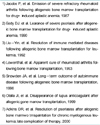References
1. Clarke DL, Johansson CB, Wilbertz J, Veress B, Nilsson E, Frisen J, et al. Generalized potential of adult neural stem cells. Science 2000. 2881660–1663.
2. Krause DS, Theise ND, Collector MI, Henegariu O, Hwang S, Sharkis SJ, et al. Multi-organ, multi-ineage engraftment by a single bone marrow-derived stem cell. Cell 2001. 105369–377.
3. Lagasse E, Connors H, Al-Dhalimy M, Reitsma M, Dohse M, Grompe M, et al. Purified hematopoietic stem cells can differentiate into hepatocytes in vivo. Nat Med 2000. 6(11)1229–1234.
4. Terada N, Hamazaki T, Oka M, Hoki M, Mastalerz DM, Scott EW, et al. Bone marrow cells adopt the phenotype of other cells by spontaneous cell fusion. Nature 2000. 416542–545.
5. Ying QL, Nichols J, Evans EP, Smith AG. Changing potency by spontaneous fusion. Nature 2002. 61229–1234.
in vivo Nat Med.
6. Jang YY, Collector MI, Baylin SB, Diehl AM, Sharkis SJ. Hematopoietic stem cells convert into liver cells within days without fusion. Nat Cell Biol 2004. 6532–539.
7. Alison MR, Poulsom R, Jeffery R, Dhillon AP, Quaglia A, Wright NA, et al. Hepatocytes from non-hepatic adult stem cells. Nature 2000. 406257.
8. Orlic D, Kajstura J, Chiment S, Limana F, Jakoniuk I, Anversa P, et al. Mobilized bone marrow cells repair the infarcted heart, improving function and survival. Proc Natl Acad Sci USA 2001. 9810344–10349.
9. Orlic D, Kajstura J, Chimenti S, Jakoniuk I, Anderson SM, Bodine DM, et al. Bone marrow cells regenerate infarcted myocardium. Nature 2001. 410701–705.
10. Kocher AA, Schuster MD, Szabolcs MJ, Takuma S, Burkhoff D, Itescu S, et al. Neovascularization of ischemic myocardium by human bone-marrow-derived angio-blasts prevents cardiomyocyte apoptosis, reduces remodeling and improves cardiac function. Nat Med 2001. 7430–436.
11. Mezey E, Chandross KJ, Harta G, Maki RA, McKercher SR. Turning blood into brain: cells bearing neuronal antigens generated in vivo from bone marrow. Science 2000. 2901779–1782.
12. Brazelton TR, Rossi FM, Keshet GI, Blau HM. From marrow to brain: expression of neuronal phenotypes in adult mice. Science 2000. 2901775–1779.
13. Hofstetter CP, Schwarz EJ, Hess D, Widenfalk J, El Manira A, Olson L, et al. Marrow stromal cells form guiding strands in the injured spinal cord and promote recovery. Proc Natl Acad Sci USA 2002. 992199–2204.
14. Li Y, Chen J, Wang L, Lu M, Chopp M. Treatment of stroke in rat with intracarotid administration of marrow stromal cells. Neurology 2001. 561666–1672.
15. Shizuru JA, Weissman IL, Kernoff R, Masek M, Scheffold YC. Purified hematopoietic stem cell grafts induce tolerance to alloantigens and can mediate positive and negative T cell selection. Proc Natl Acad Sci USA 2000. 979555–9560.
16. Kim DW, Chung YJ, Kim TG, Kim YL, Oh IH. Cotransplantation of third-party mesenchymal stromal cells can alleviate single-donor predominance and increase engraftment from double cord transplantation. Blood 2004. 1031941–1948.



